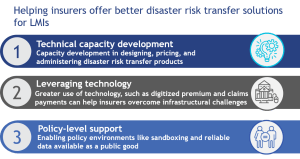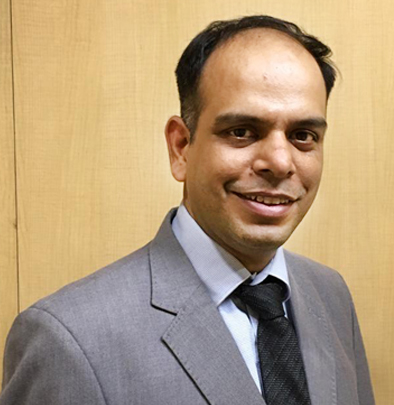An introduction to disaster risk financing Part II – Building resilience of LMI segments through disaster risk microinsurance
by Manoj Pandey, Ishita Sharma and Aneesh Gulati
Nov 13, 2020
7 min
This blog looks at success stories of how microinsurance has addressed climate and disaster risks. It also highlights how bundling helps microinsurance utilize technology and develop the technical capacity to deliver better products
The impacts of disasters and climate change events affect low-and moderate-income (LMI) individuals disproportionately. Disasters pose a greater risk to their lives and livelihoods. These events compromise the progress that the poor make to improve their living standards and emerge out of poverty. Inclusive financial services that transfer such risks and provide buffers for rehabilitation are the need of the hour. Financial service providers, including MFIs, cooperatives, and banks can play a pivotal role in offering risk transfer and management solutions.
In the first part of this two-part series, we discussed the macro landscape of disaster risk financing. In this part, we take a deeper look at microinsurance solutions that can and do enable LMI segments to manage and mitigate risks posed by climate change events. We draw from MSC’s experience with financial service providers and donor organizations in developing microinsurance solutions across emerging economies. We also examine nascent approaches that offer microinsurance solutions to address disasters and climate change and see how they can be delivered in a sustainable and scalable manner.
How does microinsurance address climate change risks and disasters?
Disaster risk microinsurance products are offered in two formats: pre-defined payout products and voluntary disaster risk insurance products. The latter offers a choice of coverage and premium bands for the insured. At present, such pre-defined cash benefit bundled products are the most common form of disaster risk (micro) insurance solutions. Standalone voluntary disaster risk insurance products on the other hand have gained importance only in recent years.
Below we see some examples of disaster risk microinsurance products:
- VimoSEWA in India has offered a bundled disaster risk insurance product for more than a decade to members who suffer damages to their homes as a result of floods. This product offers a fixed payout of INR 10,000 (~USD 132) if damages occur as a result of the disaster event. Such predefined cash benefits are the most rudimentary form of offering disaster risk insurance to the LMI segment.
- Pioneer in the Philippines provides disaster risk insurance bundled with credit products offered by CARD, its partner MFI. The beneficiaries receive a predefined payout for damages incurred or loss of life, or both, if a covered disaster, such as typhoons or floods occurs.
- In partnership with GIZ Regulatory Framework for Pro-poor Insurance (RFPI) Asia and Department of Trade and Industry (DTI), Philippines, MSC developed business interruption disaster risk insurance for MSMEs in the Philippines. After math of disasters, the top priority is to get livelihoods back up, especially micro and small enterprises. We spoke to more than 100 MSMEs in the Philippines to understand how disaster risk (micro) insurance can help MSEs recover quickly. The efforts resulted in the design and pilot of a direct cash benefit product.
Pre-defined benefit microinsurance products and when do they make sense?
Microfinance institutions have long been offering credit-life insurance to their members bundled with their credit products. The credit-life insurance products cover death arising out of disasters in the loan tenure. We have also seen above, in the case of disaster risk insurance product in the Philippines, microinsurance products that cover damages caused by disasters being offered in a similar bundle. The benefits of such bundled products are predefined and capped at a certain amount. The payout is most often triggered when the covered disaster occurs.
For beneficiaries, a pre-determined payout makes sense because:
Immediately after a disaster strikes, what enterprises and individuals most require besides healthcare and rehabilitation infrastructure is cash infusion. This helps them cope with the effects of disasters that include loss of life and health and damage to business assets, and get back up. The availability of this infusion also provides the poor a buffer against falling back into poverty. A pre-defined payout is the simplest way to offer this support to beneficiaries when it matters the most.
For insurers, an insurance product based on a predefined payout is easy to roll out:
- These products are designed and implemented simply, as they have a basic structure in terms of receiving benefit “X” if disaster “Y” occurs;
- Such products generally do not require costly and time-consuming assessments of damage as the payouts are fixed and capped.
- Payouts are triggered based on well-defined parameters, such as the breach of an index or a declaration by the government that a disaster has occurred; and
- Such products are easy to bundle with existing credit and savings products that financial service providers offer.
Voluntary disaster risk products and challenges that insurers face in offering these solutions
MSC’s study of the climate change and disaster risk landscape in Asia and Asia-Pacific allowed us to see firsthand the dearth of disaster and climate change insurance products available for LMIs and MSMEs. This led us to ask, what are some of the obstacles that prevent more insurers from offering such solutions?
MSC’s engagements with insurers in the Philippines, Vietnam, and Bangladesh revealed that most property insurance solutions cover disaster risks through additional riders that provide additional risk covers against possible losses due to disasters and catastrophic events. These riders come at extra costs, over and above the property risk premiums. However, premium bands are largely driven by market competition, and not necessarily by technical risk assessments. (“fight to be the lowest bid”). This is a challenge for insurers, as a lack of diversity of their underlying portfolios and risk concentration drives them toward losses on the risk assumed.
Representatives from an insurer in the Philippines that offers bundled (with micro-credit) insurance against calamities like typhoons commented that its premium was established based on high-level assumptions and not on technical risk assessments. When Typhoon Haiyan struck, the portfolio incurred losses due to high risk concentration and large-scale payouts, leading the insurer to increase the premium by a steep 800%.
Events like super typhoons and their increasing frequency continue to upset such simplistic pricing models and draw attention to the need to improve the technical capacities of insurers to price the risks better based on reliable weather data and emergent climate change patterns.
Insurers in emerging Asian and African markets have limited technical capacity to develop accurate climate change and disaster risk models and have limited actuarial capacities to analyze such risks. This problem is aggravated by the limited availability of reliable and affordable weather data from weather stations and satellite imagery. A combination of these factors makes it difficult for insurers to serve the LMI and MSE segments. Poor infrastructure in rural areas also makes it costly to sell, administer, and service these products.
Making disaster risk insurance sustainable and scalable
Through our interactions with insurers in Asian markets (Vietnam, Bangladesh, and the Philippines, among other geographies), we elaborate on key support areas for micro-insurers to develop and offer disaster risk insurance for the LMI segments.

- Access to technical capacity development
Product design and pricing create the foundation for the design of a sustainable disaster risk insurance portfolio. For LMI individuals, both pricing and access to the relevant product are significant constraints. Insurers need to better understand target segments that need disaster risk insurance products. Further, there is also a need to build actuarial capacities, given the enhanced risk of exposure in the face of disasters and other climate change events. The success of disaster risk microinsurance products would also depend on the insurer’s capacities in the following areas:
- Marketing of disaster risk products;
- Selling or pitching disaster risk insurance products to prospective clients;
- Developing partnerships to expand distribution channels that LMI customers, including micro and small enterprises, can access with ease;
- Accessing affordable re-insurance support for disaster risk microinsurance products.
- Use of technology to overcome infrastructure challenges
Inadequate infrastructure for financial services in rural areas poses major challenges for insurers as it increases the cost of administering disaster risk insurance and compels more manual interventions at the time of onboarding as well as claims settlement. Technology could help ease this pain point for insurers by the use of:
- Mobile phones and mobile applications for client onboarding, policy sales, and management;
- Mobile money platforms for premium collection and benefit payments; and
- Applications to monitor the product lifecycle, originate, and manage claims and declare benefits.
- Policy-level support from governments
Disaster and climate risk insurance is a relatively new industry and its markets in developing countries are even more nascent. The industry will need policy support from governments to develop. This can be accomplished by:
- Well-defined policy environment and regulations that offer tangible motivation to insurers to develop disaster risk coverage; examples of such incentives can be free access to reliable weather data and satellite imagery from state agencies, development of weather monitoring infrastructure like monitoring stations, and premium subsidies that target LMI segments, especially farmers
- Making technical support accessible for insurers and financial institutions to build their capacities in disaster risk insurance planning and design and cover knowledge gaps in the industry; one great way of doing so is to allow for regulatory sandboxes that enable insurers to pilot new products and models
The way forward
Insurers in markets including the Philippines and Bangladesh tell us that they view disaster risk insurance as a commercial opportunity. As one insurer from the Philippines said: “We have a big population, the impact of disaster events ripples through all sections of the society, so there are risks and there is a market. All we need now are models, tools, and the technical capacity to offer commercially viable solutions that also provide customers value.”
To achieve this vision, insurers must build their technical capacities, engage better with clients to understand their needs, and design solutions accordingly. MSC’s proprietary HCD tool, MI4ID, for instance, is a tested mechanism through which insurers can address client needs as part of product design. Besides, insurers must adopt technology suited to reach even remote areas in rural villages to be successful in the long run. Governments also have a role to play through the provision of reliable data and technical capacity-building to the industry. Now is the time to create and provide scalable and sustainable disaster risk insurance solutions—to safeguard vulnerable populations from the uncertainties of changing climate.
 by
by  Nov 13, 2020
Nov 13, 2020 7 min
7 min


Leave comments